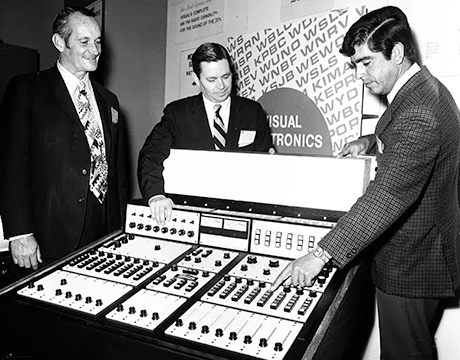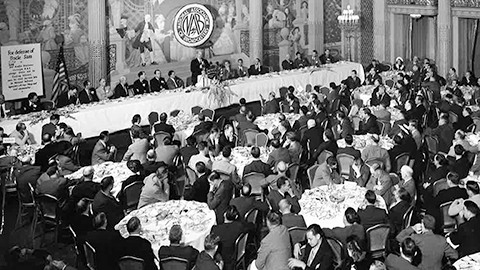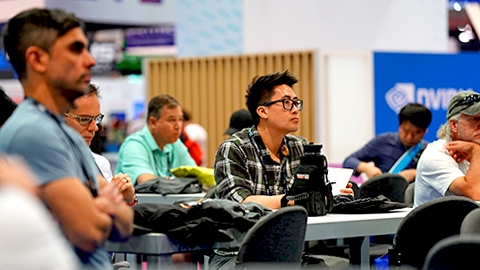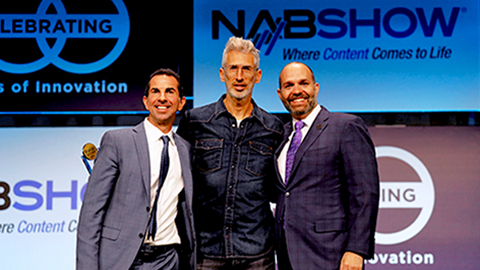NAB Show at 100
A History of Innovation & Connection, Part I

For the past 100 years, NAB Show has been a catalyst for innovation in media technology. Fueled by the vision, creativity, and technical skill of its partners and exhibitors, the annual event has evolved and expanded to address elements fundamental to reaching audiences with stories, information, and experiences that resonate.
NAB Show and the industry have adapted and grown together over the past century. The products and ideas attendees find at NAB Show speak to shifting market demand, consumer preferences, business and distribution models, standards and practices, media formats, productions workflows, technical infrastructure, and more.
A Centennial Celebration
While technologies discussed at the convention in its early years made it possible for families to gather after dinner for a radio show or news broadcast, solutions shown today enable media consumption anytime, anywhere, and on any device. How different the modern NAB Show experience in Las Vegas must be from that first official NAB convention, held Oct. 11, 1923, in New York City at the Commodore Hotel, with 16 radio stations represented among the 23 attendees.
Even with the remarkable technological advances made since then, and the tremendous growth of NAB Show itself, the purpose of the event remains relatively unchanged: to serve as a platform for exploring next-generation technology, exchanging knowledge and ideas, and connecting with colleagues and partners. And with the addition of the exhibition in 1941, the NAB convention became the venue at which to showcase — there for attendees to see and touch — the best-of-breed products powering the broadcast industry.

Early Pioneers
Italian engineer and inventor Guglielmo Marconi sent the first trans-Atlantic radio transmission in 1901, and it didn’t take long for the broadcast industry to emerge and begin a rapid course of technological development.
Gates Radio Company (predecessor to NAB Show partners Imagine Communications and GatesAir) began operations from a kitchen pantry in 1922, produced its first AM radio transmitter, the 250-Watt model 100A, in 1936, and shifted to major factory production by the 1950s. The company celebrates its 100th anniversary at the 2023 NAB Show, sharing the same centennial year.
“We consider NAB our most important show of the year. It’s a really important show for us because it allows us to showcase some of our new products. It allows us to have meetings and visit with existing customers and do some prospecting with new customers and also keep apprised of the situation with our competitors and other industry colleagues. So, it’s a great way to get a lot of business done in a few days.”
— Bruce Swail, CEO, GatesAir

Neumann, another of NAB Show’s most veteran exhibitors, was founded in Berlin in 1928. While the company is known for its microphone technology, versatile inventor and pioneer Georg Neumann simultaneously developed phonograph record-cutting machines and rechargeable batteries.
“It’s not unusual to see people who are very famous or won awards or are behind the scenes, with documentaries or movies, and they’re not here for ego; they’re here to share their knowledge. And what I like is that we can have somebody who is 90 years old and has been doing it forever, or we have students who just started out, and having that mix of experience together in one place is always a good thing.”
— Mark Pose Gay, Senior VP of Sales, Sennheiser and Neuman
Grass Valley was founded in 1959 and, within the next decade, demonstrated its first product — the 700-distribution amplifier — at the NAB Show in Chicago. The company received about 50 orders within subsequent months and went on to display four more products — a processing amplifier, another video distribution amplifier, a Synac processing module, and a sync generator — at the next year’s convention.
Years later at the at the 1977 NAB Show, Grass Valley boasted a display area of 2100 square feet, where the company exhibited its new M200 Automation System, 400 Series Routing Switcher, Effects Memory (E-MEM) system, and other products. The combination of these systems would allow a station to automate many of its functions, route signals via a keyboard, store and recall preset special effects, and other capabilities.

Broadcast Systems of the 1970s
Fifty years into NAB Show history marks the first convention held in Las Vegas, Nevada. It was the same year, 1975, that Harris (formerly Gates) exhibited its new MW-1 solid-state AM transmitter. The 1976 convention in Chicago drew 240 exhibitors, more than 10 times the exhibitors on the show floor 35 years earlier. Numerous NAB Show exhibitors experienced notable successes in this decade.
Founded in 1971, Lectrosonics is known for its wireless microphone systems and audio processing products. The company has exhibited an evolving portfolio of products and technologies at NAB Show over the years, including its groundbreaking Digital Hybrid Wireless technology, which earned a 2017 Academy Award for Technical Achievement.

Television viewers first experienced Chyron’s electronic election graphics as renowned broadcaster Walter Cronkite brought them the results of the Nov. 7, 1972, election in which Republican Pres. Richard Nixon was elected to a second term, defeating Democrat George McGovern. In the same year, the company announced at NAB Show that its Chyron II titling system could store and reproduce Chinese characters and other symbols, showing its international utility.
“One of the most memorable NAB Shows for me was when we introduced to North America a new Windows-based character generator. That became an industry standard platform, and that was tremendous as Chyron really demonstrated to the broadcast community that it was going to pivot and look forward to the future.”
— Hayes Stamper, Senior Marketing Manager, Chyron


Stay Tuned… More to Come
Part II of our series will focus on the incredible innovations of the final decades of the twentieth century, the start of the new millennium, and the amazing future of NAB Show.


